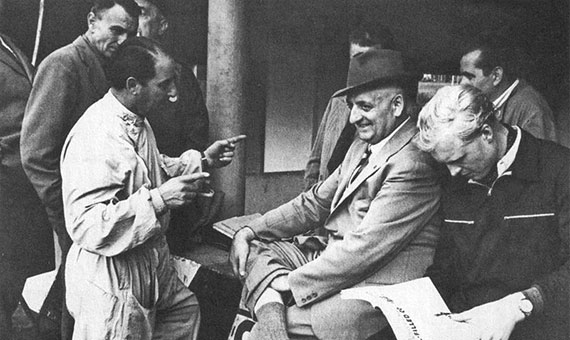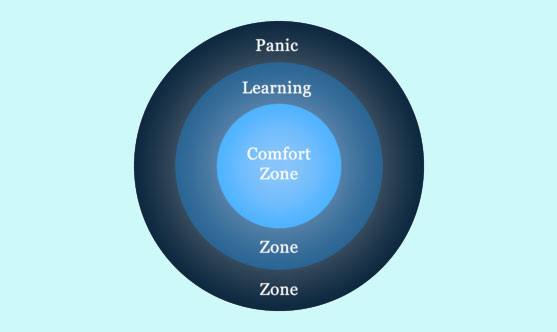“What has instructed all of the world’s builders of safe, efficient cars? Auto racing. Any theory, any laboratory experiment needs practical support, and only the race can offer it because during the race the driver submits the car and its parts to intense, unpredictable, unthinkable testing.”
As Enzo Ferrari explained it, he had the machine in mind, but auto racing is also the ultimate test for human behavior. This, as not only the drivers act at the limit, but the whole crew, what includes, for example, the mechanics and commando stand.
All involved individuals are full of adrenaline and have only very limited time to make the required decisions, a dangerous combination. The stress of the race-day pushes them out of their comfort zones. This as adrenaline is a neurotransmitter to alert all cells that the individual is an extraordinary situation, which requires the maximal use of all muscles and senses.

Each race is different, and each second something unpredictable can happen, to which driver and team have to react to. US-psychologist Walter Bradford Cannon concluded 1915 in his theory of “fight or flight” that a high level of adrenaline can block the individual’s ability for logical thinking, this as the hormone increases the heart rate to enlarge blood pressure, expand the air passages of the lungs, enlarge the pupil, redistribute blood to the muscles and alter the body’s metabolism, as to maximize blood glucose levels.[1] Thanks to evolution, adrenaline acts as a motivator. Produced in low levels, it triggers to start of cognitive processes. In high levels it provokes that the individual perceives to be in a survival situation and the primary task is to get out of this as soon as possible.[2] Originally required to escape from angry mammoths or other dangerous animals, today’s drivers need this condition to push their-selves to the limited.
German business coach Tom Senninger developed in 2000 the Learning Zone Model, where the individual is most of the time in its personal Comfort Zone. For personal growth it is required to leave this state and enter the Learning Zone to seek new experiences. The individual could motivate itself for this, or react to external stimuli. If the self- or external-motivation gets too high, the effect becomes contra-productive, as the individual reaches the Panic Zone.

The race of a business day
In business, management may use pictures as “race”, “competition” or even “war” to motivate their employees, especially if they are sales-related. Based on this description, employees produce higher levels of adrenaline, which may interfere with their capacity of logical thinking. Even if they have strong personal values, high level of stress may lead to inadequate decision making processes, where the latter behavior is incompatible with the individuals’ values.
Single decisions may get perceived as fundamental, as victories in single races or ensuring a “must win”-project. Especially when a sudden opportunity to overtake an opponent gets perceived, the race drivers try to take it; sometimes without an adequate decision making process. The results could be a race-accident where both cars have to retire from the race, or even an unfair maneuver where one car drives into the other and pushes it out of the race. Other possibilities are the usage of illegal short-cuts. With this, winning a single race may jeopardize the overall goal to ensure the championship.
Driving behind a competitor and slowly closing the gap normally does not lead to driving errors, as the driver has a plan and is able to study the competitor from safe distance (Learning Zone). But closing a gap and overtaking are two different chapters. The opponent is aware of the risk and tries to block the following driver. Such behavior is difficult to predict, so that the following driver cannot elaborate a plan for safe passing. Overtaking means more points, more money and, important, more acknowledgement. The direct fight in combination with speed and time-limit causes a stress moment (Panic Zone). But even if it the race is still long and a more passive driving-style would present a better opportunity for success, often the race driver tries to use the first perceived opportunity to pass the competitor. Already here the high stress level blocks the ability for logical decision making processes, so that perceived opportunities are often not real existent. This leads to accidents in extreme situations, to accidents between two team-colleagues or eliminations directly at the start. This as humans tend to focus on the now, instead of the long-term goal.
Such situations allow us a precious insights into human nature and how individuals act on the limit. A situation which could not be created in an experiment or laboratory, as ethics forbids us to push individuals up to the limits of their panic zones.
Behavioral Science in Mind
As the risk is identified and also the possible risk-groups, the question is, what can be done to mitigate it? Behavior is partly based on information, so one strategy to reduce stress is to reduce the level of the unknown. A case-discussion or a role-play about pros and contras of potential behavior should lead to the result that the driver will develop a (hopefully) positive attitude to not provoke accidents, or in short to “think before drive”. Companies can conduct workshops, where employees get confronted with different potential scenarios, where they have to make a decision. The results get discussed to analyze their impact on company, the individual itself and other stakeholders, including society. Knowing the potential impact raises the employee’s empathy for all affected sides and triggers even in stressful situations to elaborate an adequate decision making process and not let yourself “rushed into a decision”.
This theory gets confirmed by Oliver Sheldon’s and Ayelet Fishbach’s study for the Rutgers Business School: “If people want to avoid unethical behavior, it may help to anticipate situations where they will be tempted and consider how acting upon such temptations fits with their long-term goals or beliefs about their own morality.”[3] As conclusion, an Ethics & Compliance training can work as an “ethical vaccination”, as the positive attitude will not be activated now, but stays as “antibodies” inside the person and help to make it immune to the regarding temptations. To ensure an effective protection, such vaccinations have to be repeated from time to time. This is especially relevant for situations, where decisions have to be made inside seconds. The individual detects the risky situation and thanks to the earlier workshops already has an adequate attitude (which could be understood as a “script”), no extended decisions making process is required.”
For the case that all these moral arguments not work, the drivers have to be aware that there are efficient controls implemented. There are cameras around the track to detect all aspects of the race and race stewards speak out penalties for illegal behavior, no one is above the regulations.
To make it as easy as possible for an employee to detect a potential risk situation, workshops have to be as specific as possible, including, for example, information about the project and region. Especially if the employees travel there a first time and not know local culture and language. Often situations in foreign countries get falsely perceived and due to this, lead to wrong behavior. This includes under- or over-estimating risks.
Based on this understand, race weekends traditionally include a track-walk and driver-briefing to analyze the particular risks of a race-track and specific rules. Today such risk assessments get supported by Industry 4.0 with its possibility to identify potential patterns and predict future scenarios. Furthermore, thanks to internet, laptops and smart-phones, individuals can stay continuously connected with the Cloud, but also directly with their colleagues at the company. In Formula One, the drivers and cars are connected with the team’s command stands, including their computers. A modern F1 car can have between 150 & 300 sensors and send this information to the team. This data fosters the drivers’ and teams’ knowledge and decisions.

A discussion or a role-play (Formula One drivers often use video-games) about such pros and contras should lead to the result that the driver will develop a (hopefully) positive attitude to not provoke accidents, if one day he would be in a similar scenario. For this, an Ethics & Compliance training can work as an “ethical vaccination”, as the positive attitude will not be activated now, but stays as “antibodies” inside the person and help to make it immune to the regarding temptations. To ensure an effective protection, such vaccinations have to be repeated from time to time.
It has to be clear, thanks to these measures, the risk of non-adequate behavior gets reduced, but not to zero. Due to associate professor Morela Hernandez, individuals are not possible to concentrate on short and long-value on the same time, as our brains are not hardwired for such a possibility. [4] As conclusions, it is most relevant that management’s tone-from-the-top, in the company or racing-team, ensures that the individuals focus on the championship and not the single lap or race.
Patrick Henz
References
[1] Ivan Becrzi: Walter Cannon’s “Fight or Flight Response” – “Acute Stress Response” https://home.cc.umanitoba.ca/~berczii/hans-selye/walter-cannon-fight-or-flight-response.html
[3] Sheldon, Oliver J. / Fishbarch, Ayelet (2017): “Unethical Temptation”: https://faculty.chicagobooth.edu/ayelet.fishbach/research/Sheldon%20&%20Fishbach%20in%20Oettingen%20et%20al.pdf
[4] Hernandez, Morela (2018): “The Impossibility of Focusing on Two Things at Once”: https://sloanreview.mit.edu/article/the-impossibility-of-focusing-on-two-things-at-once/
Comments on this publication